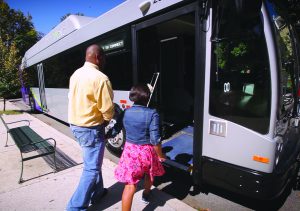Henrico shares honor following Pulse launch, GRTC route expansion
The 2018 launch of the Pulse bus rapid transit system and expansion of GRTC Transit System routes in Henrico County are being lauded by a pro-growth group as part of a “transit revolution” for the region.
The Greater Washington Partnership, a group of business leaders that promotes unity and growth from Richmond to Baltimore, on Tuesday released a case study on the region’s transit system changes. It found a 17% increase in local ridership from July 2018 through April compared with the same period the previous year. During that time, transit ridership nationally dropped by 2%, according to the study.
The partnership also presented Henrico, Richmond and Virginia a bronze award from the Institute for Transportation and Development Policy, citing the leadership and investment behind the transit expansion.
“Richmond’s transit improvements present a best-in-class road map for peer regions nationwide,” said Jason Miller, CEO of the Greater Washington Partnership. “Richmond is on its way to becoming a transit leader, further enhancing the Capital Region’s ability to attract and retain top talent. We should all be proud.”
Henrico Board of Supervisors Chairman and Varina District representative Tyrone E. Nelson said the county is proud to be a partner in the Pulse and enhanced transit service for the region.
He added that giving workers another option to access jobs strengthens Henrico’s position as an employment center. Among Virginia localities, Henrico trails only Fairfax County in the number of jobs.
“The bold steps taken in 2018 are the result of careful planning to boost mobility and connectivity for our residents, workforce and businesses,” Nelson said. “We are pleased that riders have responded so favorably. More than ever, our region is on the move, with convenient, reliable access to jobs, critical services and destinations, including Richmond International Airport.”
The study, titled Richmond’s Transit Revolution: GRTC Ridership and Accessibility Analysis, said the investments in transit have resulted in significant improvements for residents. Among other key findings, the study says:
- The changes have enhanced access to transit and jobs in both Henrico and Richmond, with Henrico households in poverty now having access to 15% more transit service on weekday evenings and weekend days. The average Richmond resident can now access nearly 2,000 more jobs by transit within an hour;
- Leaders should continue to expand the transit network in accordance with the Greater RVA Transit Vision Plan, which is designed to ensure all residents have access to economic opportunities; and
- Before the recent changes, no one in the region lived near a transit route with service every 15 minutes or less. Today, nearly 40,000 households in the area, including 27,000 households in poverty, have easy access to frequent transit.
County Manager John A. Vithoulkas credited the Board of Supervisors for providing the leadership and vision behind Henrico’s largest, locally funded expansion of transit service in 25 years. He added that employers have taken note.

“Transit provides residents with another way to get to work,” he said. “We have actually had many calls from companies that are now asking to locate along a bus line.”
The changes, initiated with an additional $1.2 million in fiscal 2018-19, brought expanded evening and weekend hours to the 7 A/B-Nine Mile Road, 91-Laburnum Connector and 19-West Broad Street routes and also extended the 19-West Broad Street route to West Broad Marketplace.
The improvements coincided with the launch of the Pulse in June 2018 and a redesign of transit service in Richmond.
Pulse has 14 stations that stretch through downtown Richmond between Willow Lawn in Henrico’s near west end and Rocketts Landing near the Richmond-Henrico line in the east end.
Transit ridership has increased across the board, according to data collected immediately following and several months after the changes took effect.
Ridership on the Henrico routes with expanded service climbed by 56%, from 10,755 to 16,771, on average per week. Ridership on all Henrico routes increased by 37%, from 16,202 to 22,218.
Similarly, overall GRTC ridership increased by 10%, from 151,196 to 165,808. Pulse ridership rose by 25%, from 31,112 to 38,832.
The Greater Washington Partnership heralded what it called a period of “transformation for transit” in the region.
“After many years of trailing its peers in transit service, Richmond has soared to the front of the pack – turning around its declining ridership with new mobility services to better meet the needs of its residents,” the study said.







